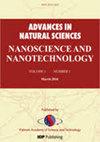Synthesis and application of ZSM-5/Graphene composite for photocatalytic degradation of industrial dyes
IF 2.1
Q3 MATERIALS SCIENCE, MULTIDISCIPLINARY
Advances in Natural Sciences: Nanoscience and Nanotechnology
Pub Date : 2024-01-19
DOI:10.1088/2043-6262/ad1a9e
引用次数: 0
Abstract
Various materials and technologies are being employed to address the concern of increased wastewater generation. In this work, the synthesis of ZSM-5 (Zeolite Socony Mobil-5) and graphene (GR) composite, their characterisation, and application for the removal of dyes are presented. Two composites of ZSM-5 and GR composites were prepared via the hydrothermal method by varying the loading amount of GR, i.e. 1% and 5%, and labelled as GZ1 and GZ5. The parent and composite materials were characterised using field emission scanning electron microscope (FE-SEM), x-ray diffraction (XRD), diffuse reflectance spectroscopy (DRS), x-ray photoelectrons spectroscopy (XPS), Raman, and Fourier transform infrared (FTIR). The materials were then employed for the photodegradation of methyl orange (MO) dye. The adsorption efficiencies for ZSM-5, GR, GZ1, and GZ5 were found as 0%, 17.8%, 0%, and 16% respectively. According to photodegradation results, the GZ1 composite exhibits the maximum degradation efficiency of 75.3% for 20 ppm of MO, within 180 min of light exposure. The scavenger studies were performed to evaluate the role of active oxygen species (AOS) in the photocatalysis mechanism. All studies were performed with the catalyst dosage of 0.5 mg ml−1. The degradation efficiencies for GR, GZ5, and Z5 were reported as 34.2%, 20.8%, and 17.5%, respectively. On increasing the irradiation time to 240 min, the degradation efficiency of GZ1 reached 92%. The removal efficiencies for MO (7 ppm) and methyl blue (5 ppm) in a 12-ppm dye mixture were observed to be 98% and 97.2% respectively within 180 min of light exposure with GZ1 composite.用于光催化降解工业染料的 ZSM-5/Graphene 复合材料的合成与应用
目前正在采用各种材料和技术来解决废水产生量增加的问题。本研究介绍了 ZSM-5(沸石 Socony Mobil-5)和石墨烯(GR)复合材料的合成、特性及其在去除染料方面的应用。通过水热法制备了两种 ZSM-5 和石墨烯复合材料,改变了石墨烯的负载量,即 1%和 5%,并标记为 GZ1 和 GZ5。使用场发射扫描电子显微镜 (FE-SEM)、X 射线衍射 (XRD)、漫反射光谱 (DRS)、X 射线光电子能谱 (XPS)、拉曼光谱和傅立叶变换红外光谱 (FTIR) 对母体材料和复合材料进行了表征。然后将这些材料用于甲基橙(MO)染料的光降解。ZSM-5、GR、GZ1 和 GZ5 的吸附效率分别为 0%、17.8%、0% 和 16%。光降解结果显示,GZ1 复合材料在光照 180 分钟内对 20 ppm MO 的降解效率最高,达到 75.3%。为了评估活性氧(AOS)在光催化机理中的作用,进行了清除剂研究。所有研究都是在催化剂用量为 0.5 mg ml-1 的条件下进行的。据报告,GR、GZ5 和 Z5 的降解效率分别为 34.2%、20.8% 和 17.5%。将辐照时间延长至 240 分钟后,GZ1 的降解效率达到了 92%。在使用 GZ1 复合材料对 12ppm 的染料混合物进行光照射 180 分钟后,对 MO(7 ppm)和甲基蓝(5 ppm)的去除率分别达到 98% 和 97.2%。
本文章由计算机程序翻译,如有差异,请以英文原文为准。
求助全文
约1分钟内获得全文
求助全文
来源期刊

Advances in Natural Sciences: Nanoscience and Nanotechnology
NANOSCIENCE & NANOTECHNOLOGYMATERIALS SCIE-MATERIALS SCIENCE, MULTIDISCIPLINARY
自引率
4.80%
发文量
0
 求助内容:
求助内容: 应助结果提醒方式:
应助结果提醒方式:


